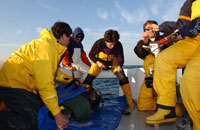
This is the time of year when the Carolina bluefin show- and the word so far is a few fish have made it down there, some big ones- but the show of fish thus far - is currently below the major years which we experienced- in the mid 1990s. Perhaps in January things will pick up. For the bluefin- I hope so- but I am getting worried.
For bluefin tuna 2008 has not been a good year as ICCAT the commission that is suppose to consider its scientific advice as it makes management quota decisions, has once again shown its unable to prevent overexploitaiton, overfishing, and the demise of Atlantic bluefin.
So much is at stake- the biodiversity of the species, the stability of the populations, the future of Atlantic bluefin as a species. I read a paper today entitled "Predicted extirpation of the dominant demersal fish in large marine ecosystem: Atlantic Cod in the Southern Gulf of St. Lawrence." It is in the latest issue of the Canadian J. of Fisheries and Aquatic Sciences Journal as a Rapid communication. Basically it says that even in the absence of all directed fishing, this animal, once the most prominent fish in the demersal ecosystem as late as the 1980s, has little chance of recovery. Extirpation was described as less than 1000t of spawning biomass, or less than 0.3% of the average spawning biomass in the 1950s. Elevated natural mortality seems to be the problem. It happens when there is a major shift in the baseline of the ecosystem, sort of the tipping point in the ecosystem- where now- so much has changed that the cod cannot recover. Why the cod cannot return here is complex but the basic premise is there are too few spawners- we took too many, and too few juvenile fish to prevent predation from replenishing the ranks
I often wonder how far we'll push the western bluefin tuna that spawn in the Gulf of Mexico- the fish I think of as true Giant Bluefin. I've been thinking a lot lately about what was the virgin biomass - of western bluefin when I was born. How far down are we now- and can the fish actually recover. I often wonder what folks 30 years from now will think of our generation of biologists, fisheries scientists, and managers. We have all the indications- we're moving beyond where we should be- into cod territory, for western Atlantic bluefin to recover, and eastern bluefin are following closely.
I only can retain hope for bluefin in the fact that our team from TAG A Giant has recently shown that the biodiversity in the genetics of the Gulf of Mexico bluefin suggests that if we stopped fishing today- we'd actually be able to retain significant genetic biodiversity from the original virign population- that is much of the original genetic biodiversity- is potentially still swimming on Earth today- in the great, great, grand children (3 or so generations removed) of the original virign Gulf of Mexico bluefin tuna (remember they have 30+ year lifespans, 12-14 year generation times, and it was only in the 1960s we began taking out all the spawners)- so, I believe- its still not too late. So we keep trying to put the facts on the table-paper after paper, and I agree with my countrymen- my local fishers from my native New England- that we do need Europe and Japan to start paying attention- to the fact that they are catching our recovery- that the consumer demand is too high. We too must also pay attention that the Last Giants ply our waters today- and every fish counts-for example how come we gave more quota in the Gulf of Mexico to western Nations. If we can't catch it thats OK- more spawners will make it. If you follow the cod trajectory this is not a good idea. So in this year of our much sought after 1000th Tag Event, and the remarkable new story on Otoliths we've published in Science in October, on how we use ear bones to provide evidence of the birthing place of individual fish- its time we hope that someone listens. Our North American stock is unique, we must do what we can to protect it.
Please Join Us - Sign Up in Support of TAG's team today: www.tagagiant.org
http://www.tagagiant.org/Donate.shtml
We need your help now to Ensure the bluefin's future! Better Yet come join us on the water in Carolina- In return for a donation you can fish with us aboard the Sensation with Captain Dale Britt
Thanks for all your support. Happy Holidays- Barb





















































